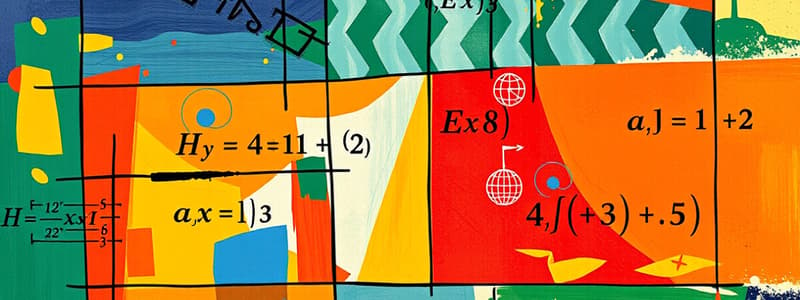Podcast
Questions and Answers
What is the primary purpose of algebra?
What is the primary purpose of algebra?
- To manipulate symbols to solve equations (correct)
- To explore calculus concepts
- To study geometric shapes
- To perform statistical analysis
Which of the following best defines a variable in algebra?
Which of the following best defines a variable in algebra?
- A symbol that represents an unknown value (correct)
- A fixed numerical value
- A symbol representing a constant value
- A statement that two expressions are equal
What is the correct order of operations in algebra?
What is the correct order of operations in algebra?
- Addition, Subtraction, Multiplication, Division
- Exponents, Parentheses, Addition, Subtraction
- Parentheses, Exponents, Multiplication and Division, Addition and Subtraction (correct)
- Multiplication, Addition, Subtraction, Parentheses
What form does a linear equation typically take?
What form does a linear equation typically take?
How can quadratic equations be solved?
How can quadratic equations be solved?
What is the definition of a function?
What is the definition of a function?
What does 'slope' refer to in a linear function?
What does 'slope' refer to in a linear function?
Which method can NOT be used to find solutions to systems of equations?
Which method can NOT be used to find solutions to systems of equations?
What is the primary difference between equations and inequalities?
What is the primary difference between equations and inequalities?
Which of the following statements is true regarding constants in algebra?
Which of the following statements is true regarding constants in algebra?
Flashcards are hidden until you start studying
Study Notes
Algebra Study Notes
-
Definition: Algebra is a branch of mathematics dealing with symbols and the rules for manipulating those symbols to solve equations and represent relationships.
-
Basic Concepts:
- Variables: Symbols (usually letters) that represent unknown values (e.g., x, y).
- Constants: Fixed values (e.g., 2, -5).
- Expressions: Combinations of variables and constants using operations (e.g., 3x + 2).
- Equations: Statements that two expressions are equal (e.g., 2x + 3 = 7).
-
Operations:
- Addition, Subtraction, Multiplication, Division
- Order of Operations: PEMDAS (Parentheses, Exponents, Multiplication and Division, Addition and Subtraction).
-
Solving Equations:
- Isolate the variable (e.g., add/subtract terms).
- Use inverse operations to solve for the variable.
- Check the solution by substituting back into the original equation.
-
Types of Equations:
- Linear Equations: Form y = mx + b, where m is the slope and b is the y-intercept.
- Quadratic Equations: Form ax² + bx + c = 0, can be solved using factoring, completing the square, or the quadratic formula x = (-b ± √(b²-4ac))/(2a).
- Polynomial Equations: Involves terms with variables raised to whole number exponents.
-
Functions:
- A relation where each input has exactly one output.
- Notation: f(x), g(x), etc.
- Types: Linear, Quadratic, Exponential, etc.
-
Graphing:
- Plotting points on a coordinate plane.
- Understanding slopes (rise/run) for linear functions.
- Identifying intercepts (where the graph crosses axes).
-
Systems of Equations:
- Set of two or more equations with the same variables.
- Solutions can be found using:
- Graphing
- Substitution
- Elimination
-
Inequalities:
- Similar to equations but use >, <, ≥, or ≤.
- Solutions may include a range of values.
-
Factoring:
- Rewriting expressions as products of factors.
- Common methods: factoring out the greatest common factor, using the difference of squares, or applying the quadratic formula.
-
Applications:
- Solving real-world problems involving relationships, rates, and quantities.
- Used in fields such as engineering, economics, and natural sciences.
Algebra Overview
- Algebra involves symbols and rules for manipulating them to solve equations and express relationships.
- It serves as a foundational mathematical discipline applied in various fields.
Basic Concepts
- Variables: Symbols like x and y denote unknown values.
- Constants: Fixed numerical values, such as 2 or -5.
- Expressions: Combinations formed by variables and constants through operations (e.g., 3x + 2).
- Equations: Show that two expressions are equal (e.g., 2x + 3 = 7).
Operations
- Core operations include addition, subtraction, multiplication, and division.
- Order of Operations: Follow PEMDAS: Parentheses, Exponents, Multiplication and Division, Addition and Subtraction.
Solving Equations
- Steps to solve an equation include isolating the variable, using inverse operations, and checking the solution by substitution.
Types of Equations
- Linear Equations: Structured as y = mx + b, where m indicates slope and b signifies the y-intercept.
- Quadratic Equations: Formed as ax² + bx + c = 0, solvable through factoring, completing the square, or the quadratic formula x = (-b ± √(b²-4ac))/(2a).
- Polynomial Equations: Include terms with variable exponents that are whole numbers.
Functions
- Defined as relations where each input corresponds to one output.
- Notation typically includes f(x), g(x), etc., with various types like Linear, Quadratic, and Exponential.
Graphing
- Involves plotting points on a coordinate plane to visualize equations.
- Critical concepts include calculating slopes (rise/run) for linear functions and identifying intercepts (points where graphs cross axes).
Systems of Equations
- Comprise multiple equations sharing common variables.
- Solutions can be determined through graphing, substitution, or elimination methods.
Inequalities
- Similar to equations but express relationships using symbols like >, <, ≥, and ≤.
Studying That Suits You
Use AI to generate personalized quizzes and flashcards to suit your learning preferences.




